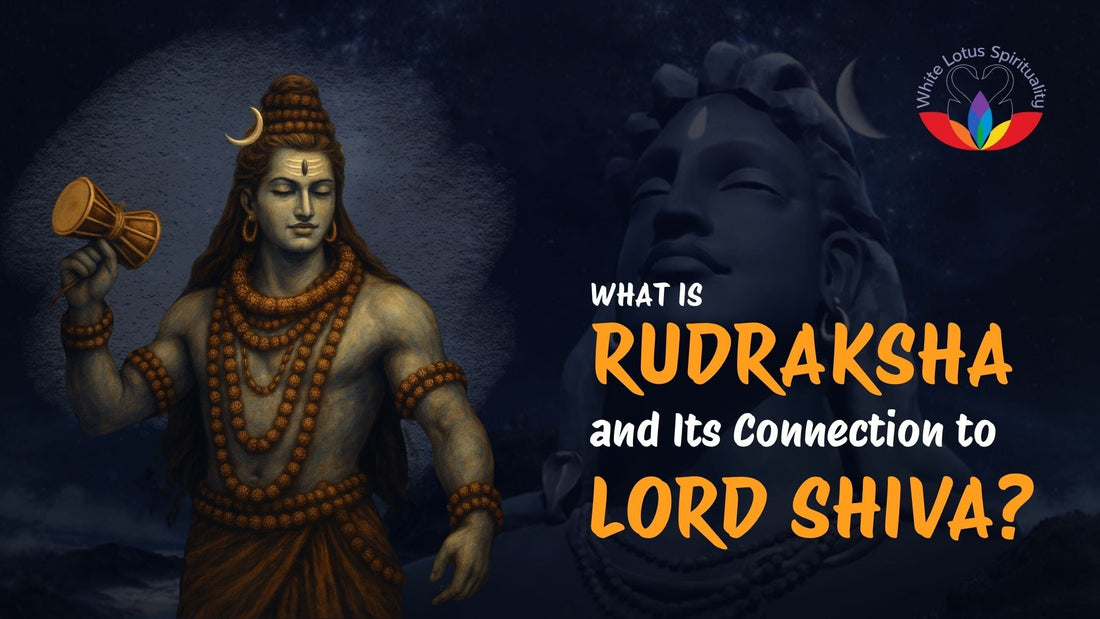
What is Rudraksha and Its Connection to Lord Shiva?
Share
Rudraksha, being a sacred seed in Hindu mythology, is a highly spiritual and mythologically inclined product to a great extent. It is a product of ancient Indian heritage and not only a sacred bead that serves the spiritual endeavor, but also a representation of God Shiva and the gods themselves.
The small brown bead with its natural imperfections allegedly contained powerful energies that could heal the mind, body, and soul.
In this blog, we'll explore what Rudraksha is, its historical and mythological significance, particularly its connection to Lord Shiva, and why millions of devotees worldwide continue to wear it as a spiritual protection.
What is Rudraksha?
Rudraksha is the dried seed of the Elaeocarpus ganitrus fruit and is found primarily in the Himalayan range, as well as in Nepal, Indonesia, and Southeast Asia. "Rudraksha" is a compound
Sanskrit term: Rudra (Lord Shiva's frightful form) and Aksha (eyes). Rudraksha thus means "the tears of Rudra."
Seeds of Rudraksha have varied "mukhis" or faces, natural divisions or blemishes from top to bottom of the bead. There exist one to twenty-one mukhis on each Rudraksha bead, and a varying number of gods and virtues are linked with each of them. Panchmukhi (five-faced) Rudraksha is highly sought after and utilized among them.
The Mythological Origin of Rudraksha
According to Hindu scriptures such as the Shiva Purana, Padma Purana, and Devi Bhagavata Purana, Rudraksha is described as having been created from the tears of Lord Shiva. According to legend, Lord Shiva, in ancient times, meditated for thousands of years to ensure the safety of human beings. His eyes being open, some tears fell from them and landed on the ground. The tears of these gods have evolved into Rudraksha trees, and the seeds from these trees are now known as Rudraksha beads.
Rudraksha is not only a seed; it is also a symbol of Shiva's compassion and divine energy.
Rudraksha as a Symbol of Lord Shiva
Lord Shiva is often depicted wearing Rudraksha beads around his neck, arms, wrists, and even in his hair. They are his sacred attire and symbolize his proximity to nature, humility, and divine wisdom. Rudraksha is one of the five nectars (Panchamrits) utilized in the worship of Lord Shiva, the remaining four being water, milk, honey, curd, and ghee.
As per the Shiva Purana, Rudraksha is nothing short of the devotion of Lord Shiva himself. Rudraksha possesses the divine power of Shiva, and the person who wears it comes closer to his grace, is safeguarded, attains peace of mind, and experiences spiritual development.
Aside from religious belief, Rudraksha beads are also believed to have special electromagnetic properties.
In spiritual practices, Rudraksha beads are worn during meditation, and mantras are chanted, especially the "Om Namah Shivaya" mantra. It is used to sharpen one's concentration, calm the mind, and purify the aura.
Correct Wearing of Rudraksha
If you are worried about wearing Rudraksha, don't worry; there are no strict rules. However, what matters most is a positive attitude. Don't wear Rudraksha when evil thoughts enter your mind, or believe that success is obtained without hard work. Rudraksha is not for those who are lazy or miracle-seekers who do not want to work hard. Rudraksha aids sincere efforts and enhances your success possibilities if combined with effort, aura cleansing, chakra balancing, and sadhana.
Natural Rudraksha beads can accelerate progress for individuals who possess clear, positive thoughts. Rudraksha, when paired with appropriate beeja mantras and spiritual practice, can effect change in one's life if it is filled with negativity.
Rudraksha is best worn about the neck, close to the heart chakra. If, however, worn on the hands, according to tradition, odd-numbered Rudraksha are worn on the left hand and even-numbered ones on the right. Rudraksha will help strengthen your inner and personal growth when used in conjunction with proper intention and discipline.
How Rudraksha Works
Authentic Rudraksha beads are equivalent to an interchangeable, dynamic battery or capacitor, which charges and discharges bioelectrical energy as and when needed.
Our physical body also has a built-in electrical current with permanent polarities, with the head serving as the north pole and the feet serving as the south pole. Interchangeable and dynamic polarities in Rudraksha beads render them unique.
For example, if Mercury is in a weak state in your horoscope, it may lead to cardiac ailments due to electrical interference within cardiac cells. A 15 Mukhi Rudraksha will remove these imbalances from the cellular level by detecting with a reverse microvoltage charge, allowing for cellular recovery.
Rudraksha works at the cellular level, where every cell, composed of RNA, DNA, and amino acids, possesses electrical charges. Since each organ requires a different voltage, various Rudraksha beads yield other benefits. For instance, the 15 Mukhi Rudraksha strengthens the cardiac system, the 17 Mukhi Rudraksha stimulates the pineal gland, and the 8 Mukhi Rudraksha (which is connected to Ketu) stimulates the pituitary gland.
So, Rudraksha helps our body's endocrine system as well as energy system constructively.
Conclusion
Rudraksha is not just a symbol of spirituality; it embodies Lord Shiva's mercy, which is a manifestation of his compassion and divine grace. Rudraksha is said to be the work of holy consciousness. If you want to cultivate spirituality, mental peace, or physical health, it can be a valuable aid.
In times of trouble and distraction, Rudraksha serves as an inner anchor, a timeless journey to Lord Shiva, and a shattering of timelessness within us.
So, whether you are on a quest for self-realization or just looking for the kindness of Shiva, putting on a Rudraksha as a pendant around your neck can prove to be a powerful spiritual decision
